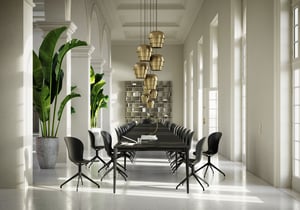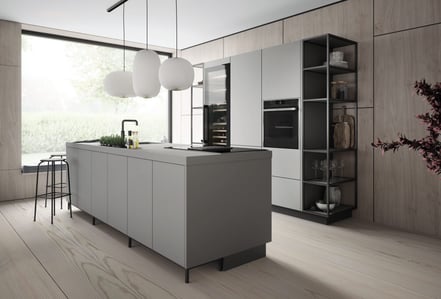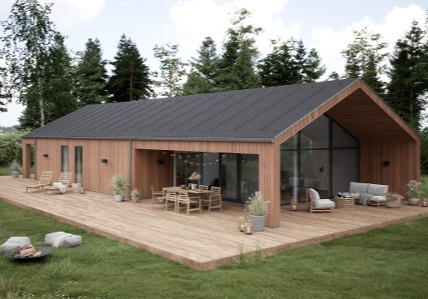Do you work in the home improvement industry, offering products like windows, doors, awnings, tiles, paint, or similar items?
Whether selling your products directly to end-users or through retailers, you must focus on building a solid preference with consumers. By embracing cutting-edge solutions that align with the latest customer experience trends, you can significantly boost the chances of customers choosing your products over those of your competitors.
Get ready to learn more about these 4 customer experience trends:
- Provide the bigger picture - sell the dream, not the product
- Omnichannel customer journeys - create a seamless blend of online and in-store experiences
- Assembly animations and interactive guides - make assembly easy and engaging
- Live shopping - make online shopping personal
1. Provide the bigger picture
Sell the dream, not the product
You do not just sell flooring, paint, or stoves. You sell the tools that allow your customers to live in their dream setting.
People want to easily imagine how products will fit into their lives. But that’s not easy when all they have to look at is a square of color or an image of a small section of herringbone flooring.
This is where lifestyle images can be very helpful. When customers see a product integrated into an environment that feels familiar, they can visualize how it could fit into their own lives. This emotional connection turns a product from something abstract into something tangible, making it more desirable. It’s not just about showcasing features—it’s about creating a lifestyle narrative where the product becomes an essential part of the story.
However, finding an ideal location to install your herringbone flooring or painting and repainting a room to show the effect of different trendy colors will, in most cases, be impossible. But with CGI, the perfect lifestyle setting can be created and infinitely varied with your different home improvement products.
Get to know more about the advantages of creating lifestyle images with CGI.

2. Omnichannel customer journeys
Create a seamless blend of online and in-store experiences
Customers no longer differentiate between online and in-store experiences. They expect seamless transitions between browsing products online, personalizing their options through configurators, and getting in-store assistance. Creating an omnichannel experience means engaging your customers at every touchpoint—whether researching, browsing, shopping from home, or visiting your showroom.
2.1. Start from home, finish in-store
One of the most significant shifts in customer behavior continues to be the seamless blending of
digital and in-person shopping. Many customers begin their product research and decision-making
process at home, often using online tools like 3D product configurators. Here, they can explore various options, compare materials, and visualize how products will look in their own homes.
Offering a configurator with live pricing, material lists, and customization options encourages customers to build a relationship with the product digitally, making their in-store visit quicker and more purposeful. As more home improvement brands adopt this approach, CGI-supported configurators and product previews will become vital for creating the perfect omnichannel experience.
Learn more about the different kinds of 3D product configurators we can create for you.
This trend allows brands to engage with customers early in the decision-making process, offering
detailed visualizations that increase confidence before they step into the store. Then, when they
arrive at a physical location, they’re well-informed and ready to finalize their purchase.

2.2. Immersive experiences with AR and VR
Augmented and virtual reality are rapidly advancing technologies, and the potential for companies in the home improvement sector is immense.
One of the most significant challenges in this industry is helping customers envision how a product will look and function in their homes. Whether they’re choosing new flooring, windows, paint colors, or fixtures, customers often need help picturing how different options will fit into their existing home layout. AR bridges this gap by overlaying digital renderings
of products onto real-world environments.
This “try-before-you-buy” capability helps customers visualize items in their actual homes using just
a smartphone or tablet, boosting their confidence in the decision-making process. It’s the perfect match for people who want to start shopping from the comfort of their homes.
VR takes this a step further by offering fully immersive experiences where customers can explore entire spaces in 3D, walking through a virtual representation of their future kitchen, bathroom, or living room. This level of immersion gives customers a tangible sense of scale and design flow, enabling them to see how various elements come together holistically. Such technology is especially valuable for complex renovation projects or new builds, where visualizing the end result is difficult.
Learn how RAIS seamlessly connects their 3D product configurator and their AR solution.
2.3. Bring the digital experiences into the store
While customers may start their journey online, many still value the tactile experience of visiting a store. However, digital technology continues to enhance in-store shopping, merging physical exploration with interactive digital demonstrations. This trend focuses on integrating intelligent displays, interactive cut-throughs, and product configurators, allowing customers to adjust product options, review their previous configurations, and see products through immersive digital experiences.
In-store demonstrations make it easier for customers to visualize complex products, especially those with multiple components or installation steps, while also linking back to the research they did at home. This enhances the in-store experience and adds another layer of convenience, ensuring customers can access the same tools and options in the showroom as they did online.
Try the Petersen Tegl configurator for yourself.
3. Assembly animations and interactive guides
Make assembly easy and engaging
The era of paper-based assembly manuals filled with line drawings and dense text is rapidly being replaced by more engaging formats like video and interactive digital guides. For companies in the home improvement sector, embracing this trend can significantly enhance the customer experience even in the early stages of the buying journey and simplify the post-purchase assembly process, ultimately fostering stronger brand loyalty and satisfaction from start to finish.
Click the image below to watch an assembly animation that we made for Egernsund Tegl that was out of the ordinary.
Video assembly guides have long been popular due to their ease and clarity. Most people are visual learners, making video a more intuitive format than written instructions. Instead of flipping through pages, customers can watch each step, pausing or rewinding as needed. This approach reduces frustration, especially with complex assemblies.
Having animated assembly videos can become part of the reason why a customer chooses your product instead of your competitors, simply because of the importance of convenience. Together with the added fact that videos are more popular than ever when people are researching products or processes, having your product featured in different kinds of videos can make a huge difference due to added exposure. That makes it easier to build preference from the start.
The growth of DIY and e-commerce also underscores the need for accessible, self-service assembly solutions. Customers now expect seamless support to guide them through installations, and interactive guides perfectly fit this demand. Digital and video instructions allow people to approach projects at their own pace, appealing to a wider range of skill levels. This trend aligns with a broader industry shift toward comprehensive customer support that’s both user-friendly and available on demand.
Instead of having the hassle of trying to film assembly videos the traditional way, CGI is a perfect alternative, offering precision and clarity that standard filming often can’t achieve. With CGI, home improvement companies can showcase every assembly step with complete accuracy and seamless visuals, ensuring each part is perfectly aligned and easily identifiable.
4. Live shopping
Make online shopping personal
If you think live shopping is just for fashion and tech, it’s time to reconsider. This interactive, social- commerce format transforms segments, including home improvement, making selling products like doors, windows, tiles, and flooring easier.
More people are opting for the convenience of online shopping, where they can avoid the pressure of in-store salespeople. Live shopping offers a unique opportunity to connect with your customers in real-time. It’s more than just a video stream; you can sell off-the-shelf products while participating in an engaging consultation where customers can ask questions, compare options, and see products in action from the comfort of their homes.
To succeed with this trend, it’s crucial that your products look their very best online since this is where your customers will make their decisions. High-quality CGI can achieve this.
By integrating intricate product visuals, revealing cut-throughs offering an in-depth look at product specifics, dynamic 360-degree spinners, and captivating lifestyle imagery, you empower your customers to envision your products in their own environments. Whether you’re demonstrating the
durability of your flooring or showcasing different window designs, CGI helps you create an experience that feels tangible and personal.

















